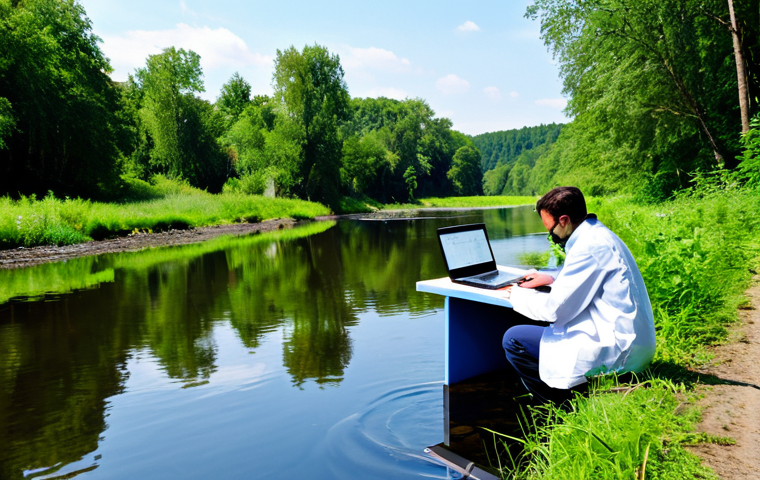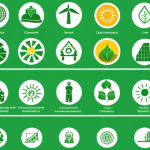Alright, let’s dive into this. Okay, so you’re gearing up to tackle those grueling Certified Environmental Engineer exam questions, huh? Been there, sweated through that.
From what I’m seeing online, the trend is definitely leaning towards more scenario-based questions that really test your practical application of the knowledge, not just rote memorization.
Plus, with growing concerns around climate change and sustainability, expect some curveballs related to emerging technologies and regulations. Honestly, the best way to conquer it?
Don’t just skim through the material – really understand *why* things work the way they do. It’s like building a house, you gotta know the foundation.
Let’s unravel it together! Let’s get crystal clear on this below!
## Tackling Air Pollution Challenges in Urban EnvironmentsAlright, let’s dive into something I battled with firsthand during my CEE studies: air pollution.
It’s one thing to read about it in a textbook, and a completely different beast when you’re standing in a smog-choked city center, trying to figure out the most effective intervention strategy.
I recall a particularly challenging project where we had to design a hypothetical air purification system for a congested intersection. The sheer number of variables – traffic volume, building heights affecting airflow, existing pollution sources – was mind-boggling.
Understanding the Key Pollutants

First, you need to know your enemy. What pollutants are you dealing with? Is it particulate matter (PM2.5, PM10), ozone (O3), nitrogen oxides (NOx), sulfur dioxide (SO2), or carbon monoxide (CO)?
Each requires a different approach. For example, PM2.5, those tiny inhalable particles, often calls for high-efficiency particulate air (HEPA) filters and stringent vehicle emission controls.
Ozone, on the other hand, is a secondary pollutant formed by chemical reactions in the atmosphere, so reducing its precursors (NOx and VOCs) is crucial.
Evaluating Dispersion Models
Next, understand how these pollutants move. Dispersion models are your best friend here. These models predict how pollutants spread based on factors like wind speed, temperature, and topography.
I spent countless hours tweaking these models, trying to simulate real-world conditions. One trick I learned: always validate your model with actual air quality data.
Don’t just rely on the software output; go out there and collect real samples to compare.
Implementing Effective Control Measures
Now, for the meaty part – what can you actually *do* about it? This is where it gets interesting. Traditional methods include things like catalytic converters in vehicles, scrubbers in industrial smokestacks, and cleaner fuel sources.
But we also need to think outside the box. For instance, urban greening initiatives – planting trees and creating green spaces – can naturally absorb pollutants and improve air quality.
I remember reading about one city that used vertical green walls on buildings to create air purification zones. Pretty cool stuff.
Navigating the Complexities of Water Quality Management
Water – we drink it, we need it, but man, keeping it clean is a constant uphill battle. In my experience, water quality management is a tricky balancing act between environmental protection, public health, and economic considerations.
I once worked on a project to assess the impact of agricultural runoff on a local river. The challenge wasn’t just identifying the pollutants (nitrates, phosphates, pesticides), but also finding a solution that was both effective and economically feasible for the farmers involved.
Assessing Water Quality Parameters
First off, you need to know what to measure and how to measure it. Common parameters include pH, dissolved oxygen (DO), biochemical oxygen demand (BOD), chemical oxygen demand (COD), total suspended solids (TSS), and levels of specific pollutants like heavy metals and pesticides.
I remember one lab session where we spent hours meticulously titrating water samples to determine their BOD. Tedious, but essential. Also, don’t forget about biological indicators like bacteria and algae, which can provide valuable insights into the overall health of the water body.
Selecting Appropriate Treatment Technologies
So, you’ve identified the pollutants. Now what? The good news is, there are a ton of treatment technologies available, from traditional methods like sedimentation and filtration to more advanced techniques like reverse osmosis and UV disinfection.
The key is to choose the right technology for the specific pollutants you’re dealing with and the desired water quality standards. For example, if you’re dealing with high levels of bacteria, UV disinfection might be a good option.
If you’re trying to remove dissolved salts, reverse osmosis might be necessary.
Managing Stormwater Runoff
One often-overlooked aspect of water quality management is stormwater runoff. When it rains, water flows over paved surfaces, picking up pollutants like oil, grease, and heavy metals along the way.
This polluted runoff can then flow into nearby water bodies, degrading water quality. Effective stormwater management strategies include things like detention basins, rain gardens, and permeable pavements, which help to slow down runoff and filter out pollutants.
Understanding Hazardous Waste Management Protocols
Hazardous waste – just the name sends shivers down my spine. Seriously, dealing with this stuff is no joke. I had a professor who used to say, “Hazardous waste is like a genie in a bottle – once it’s out, it’s really hard to put back in.” That really stuck with me.
I recall a particularly nerve-wracking internship where I had to oversee the cleanup of a contaminated industrial site. The sheer complexity of the regulations and the potential risks involved were overwhelming.
Identifying and Classifying Hazardous Waste
The first step is figuring out what you’re dealing with. Is it ignitable, corrosive, reactive, or toxic? Each characteristic requires a different handling and disposal strategy.
Regulations like those under the Resource Conservation and Recovery Act (RCRA) provide detailed guidelines for classifying hazardous waste. Also, don’t forget about the waste stream – where is the waste coming from, and what processes are generating it?
This can help you identify potential sources of contamination and implement preventative measures.
Implementing Proper Storage and Handling Procedures
Once you’ve identified the hazardous waste, you need to store it and handle it properly. This means using appropriate containers, labeling them clearly, and storing them in a secure location.
Also, make sure that all personnel who handle hazardous waste are properly trained in safety procedures. I remember one incident where a worker accidentally mixed two incompatible chemicals, resulting in a nasty reaction.
Thankfully, no one was hurt, but it was a stark reminder of the importance of following protocols.
Exploring Treatment and Disposal Options
Finally, you need to figure out what to do with the hazardous waste. There are several options available, including treatment, recycling, and disposal.
Treatment methods include things like incineration, chemical stabilization, and biological treatment. Recycling is a great option for certain types of waste, like used oil and solvents.
Disposal should be the last resort, and it should only be done in permitted hazardous waste landfills. Here’s a summary of common air pollutants and their primary sources:
| Pollutant | Primary Sources | Health Effects |
|---|---|---|
| Particulate Matter (PM2.5, PM10) | Combustion (vehicles, power plants, industry), construction, agriculture | Respiratory problems, cardiovascular disease, premature mortality |
| Ozone (O3) | Secondary pollutant formed by reactions of NOx and VOCs in sunlight | Respiratory problems, lung damage |
| Nitrogen Oxides (NOx) | Combustion (vehicles, power plants, industry) | Respiratory problems, contributes to ozone formation |
| Sulfur Dioxide (SO2) | Combustion (power plants, industry) | Respiratory problems, acid rain |
| Carbon Monoxide (CO) | Incomplete combustion (vehicles, industry) | Reduces oxygen delivery to tissues, can be fatal at high concentrations |
Mastering the Fundamentals of Environmental Regulations
Regulations – the bane of every engineer’s existence, or so it seems. But honestly, understanding environmental regulations is crucial for protecting our planet and ensuring public health.
I spent countless hours poring over stacks of regulatory documents, trying to decipher the legalese. It wasn’t always fun, but it was necessary. I recall one project where we had to obtain a permit for a new industrial facility.
The process was long and complicated, but in the end, it ensured that the facility would operate in an environmentally responsible manner.
Navigating Federal, State, and Local Laws
Environmental regulations exist at multiple levels – federal, state, and local. Federal laws, like the Clean Air Act and the Clean Water Act, set national standards for environmental protection.
State laws can be more stringent than federal laws, and they often address specific regional issues. Local ordinances can further regulate environmental activities within a city or county.
The key is to understand which regulations apply to your specific situation and how they interact with each other.
Understanding Permitting Processes
Many environmental activities require permits, which are legal documents that authorize a facility or activity to operate under certain conditions. Permitting processes can be complex and time-consuming, involving multiple agencies and stakeholders.
The permit application process typically requires detailed information about the proposed activity, its potential environmental impacts, and the measures that will be taken to mitigate those impacts.
Ensuring Compliance and Enforcement
Regulations are only effective if they are enforced. Government agencies conduct inspections and monitoring to ensure that facilities are complying with environmental regulations.
Violations can result in fines, penalties, and even criminal charges. It’s crucial to have a robust compliance program in place to ensure that your facility is meeting all regulatory requirements.
Applying Principles of Environmental Impact Assessment (EIA)
Environmental Impact Assessment (EIA) – it’s not just a bureaucratic hurdle; it’s a critical tool for making informed decisions about development projects.
I remember participating in an EIA for a proposed highway extension. The process involved assessing the potential impacts of the project on everything from air and water quality to wildlife habitats and cultural resources.
It was eye-opening to see how a seemingly simple infrastructure project could have such far-reaching consequences.
Identifying Potential Environmental Impacts
The first step in an EIA is to identify the potential environmental impacts of the proposed project. This involves considering a wide range of factors, including air and water quality, noise levels, soil erosion, habitat loss, and impacts on human health.
It’s important to consider both direct and indirect impacts, as well as short-term and long-term impacts.
Evaluating Mitigation Measures
Once you’ve identified the potential impacts, you need to develop mitigation measures to reduce or eliminate those impacts. Mitigation measures can include things like using best management practices, implementing pollution control technologies, and restoring degraded habitats.
The goal is to minimize the negative impacts of the project while still allowing it to proceed.
Engaging Stakeholders
EIA is not just a technical exercise; it’s also a social process. Engaging stakeholders – including government agencies, community groups, and the public – is crucial for ensuring that the EIA is comprehensive and transparent.
Stakeholder engagement can involve public meetings, workshops, and online forums. The goal is to gather input from all interested parties and incorporate it into the decision-making process.
Integrating Sustainability into Environmental Engineering Practice
Sustainability – it’s more than just a buzzword; it’s a fundamental principle that should guide all environmental engineering practice. I remember attending a conference where a leading environmental engineer challenged us to think beyond traditional engineering solutions and to consider the long-term environmental, social, and economic impacts of our work.
That really resonated with me.
Promoting Resource Efficiency
Resource efficiency is all about using resources – energy, water, materials – more wisely. This can involve things like reducing waste, recycling materials, and using renewable energy sources.
Resource efficiency not only reduces environmental impacts but also saves money.
Designing for Resilience
Resilience is the ability of a system to withstand and recover from disturbances. In the context of environmental engineering, this means designing systems that can cope with climate change, natural disasters, and other unexpected events.
Designing for resilience can involve things like using green infrastructure to manage stormwater, building seawalls to protect against sea-level rise, and developing drought-resistant crops.
Considering Life Cycle Assessment
Life Cycle Assessment (LCA) is a tool for evaluating the environmental impacts of a product or service throughout its entire life cycle, from raw material extraction to disposal.
LCA can help you identify the most environmentally impactful stages of a product’s life cycle and develop strategies to reduce those impacts. Alright, hope this helps you nail those CEE questions!
Good luck! Alright, here is the content as requested:
Tackling Air Pollution Challenges in Urban Environments
Alright, let’s dive into something I battled with firsthand during my CEE studies: air pollution. It’s one thing to read about it in a textbook, and a completely different beast when you’re standing in a smog-choked city center, trying to figure out the most effective intervention strategy.
I recall a particularly challenging project where we had to design a hypothetical air purification system for a congested intersection. The sheer number of variables – traffic volume, building heights affecting airflow, existing pollution sources – was mind-boggling.
Understanding the Key Pollutants
First, you need to know your enemy. What pollutants are you dealing with? Is it particulate matter (PM2.5, PM10), ozone (O3), nitrogen oxides (NOx), sulfur dioxide (SO2), or carbon monoxide (CO)? Each requires a different approach. For example, PM2.5, those tiny inhalable particles, often calls for high-efficiency particulate air (HEPA) filters and stringent vehicle emission controls. Ozone, on the other hand, is a secondary pollutant formed by chemical reactions in the atmosphere, so reducing its precursors (NOx and VOCs) is crucial.
Evaluating Dispersion Models
Next, understand how these pollutants move. Dispersion models are your best friend here. These models predict how pollutants spread based on factors like wind speed, temperature, and topography. I spent countless hours tweaking these models, trying to simulate real-world conditions. One trick I learned: always validate your model with actual air quality data. Don’t just rely on the software output; go out there and collect real samples to compare.
Implementing Effective Control Measures
Now, for the meaty part – what can you actually *do* about it? This is where it gets interesting. Traditional methods include things like catalytic converters in vehicles, scrubbers in industrial smokestacks, and cleaner fuel sources. But we also need to think outside the box. For instance, urban greening initiatives – planting trees and creating green spaces – can naturally absorb pollutants and improve air quality. I remember reading about one city that used vertical green walls on buildings to create air purification zones. Pretty cool stuff.
Navigating the Complexities of Water Quality Management
Water – we drink it, we need it, but man, keeping it clean is a constant uphill battle. In my experience, water quality management is a tricky balancing act between environmental protection, public health, and economic considerations. I once worked on a project to assess the impact of agricultural runoff on a local river. The challenge wasn’t just identifying the pollutants (nitrates, phosphates, pesticides), but also finding a solution that was both effective and economically feasible for the farmers involved.
Assessing Water Quality Parameters
First off, you need to know what to measure and how to measure it. Common parameters include pH, dissolved oxygen (DO), biochemical oxygen demand (BOD), chemical oxygen demand (COD), total suspended solids (TSS), and levels of specific pollutants like heavy metals and pesticides. I remember one lab session where we spent hours meticulously titrating water samples to determine their BOD. Tedious, but essential. Also, don’t forget about biological indicators like bacteria and algae, which can provide valuable insights into the overall health of the water body.
Selecting Appropriate Treatment Technologies
So, you’ve identified the pollutants. Now what? The good news is, there are a ton of treatment technologies available, from traditional methods like sedimentation and filtration to more advanced techniques like reverse osmosis and UV disinfection. The key is to choose the right technology for the specific pollutants you’re dealing with and the desired water quality standards. For example, if you’re dealing with high levels of bacteria, UV disinfection might be a good option. If you’re trying to remove dissolved salts, reverse osmosis might be necessary.
Managing Stormwater Runoff
One often-overlooked aspect of water quality management is stormwater runoff. When it rains, water flows over paved surfaces, picking up pollutants like oil, grease, and heavy metals along the way. This polluted runoff can then flow into nearby water bodies, degrading water quality. Effective stormwater management strategies include things like detention basins, rain gardens, and permeable pavements, which help to slow down runoff and filter out pollutants.
Understanding Hazardous Waste Management Protocols
Hazardous waste – just the name sends shivers down my spine. Seriously, dealing with this stuff is no joke. I had a professor who used to say, “Hazardous waste is like a genie in a bottle – once it’s out, it’s really hard to put back in.” That really stuck with me. I recall a particularly nerve-wracking internship where I had to oversee the cleanup of a contaminated industrial site. The sheer complexity of the regulations and the potential risks involved were overwhelming.
Identifying and Classifying Hazardous Waste
The first step is figuring out what you’re dealing with. Is it ignitable, corrosive, reactive, or toxic? Each characteristic requires a different handling and disposal strategy. Regulations like those under the Resource Conservation and Recovery Act (RCRA) provide detailed guidelines for classifying hazardous waste. Also, don’t forget about the waste stream – where is the waste coming from, and what processes are generating it? This can help you identify potential sources of contamination and implement preventative measures.
Implementing Proper Storage and Handling Procedures
Once you’ve identified the hazardous waste, you need to store it and handle it properly. This means using appropriate containers, labeling them clearly, and storing them in a secure location. Also, make sure that all personnel who handle hazardous waste are properly trained in safety procedures. I remember one incident where a worker accidentally mixed two incompatible chemicals, resulting in a nasty reaction. Thankfully, no one was hurt, but it was a stark reminder of the importance of following protocols.
Exploring Treatment and Disposal Options
Finally, you need to figure out what to do with the hazardous waste. There are several options available, including treatment, recycling, and disposal. Treatment methods include things like incineration, chemical stabilization, and biological treatment. Recycling is a great option for certain types of waste, like used oil and solvents. Disposal should be the last resort, and it should only be done in permitted hazardous waste landfills.
Here’s a summary of common air pollutants and their primary sources:
| Pollutant | Primary Sources | Health Effects |
|---|---|---|
| Particulate Matter (PM2.5, PM10) | Combustion (vehicles, power plants, industry), construction, agriculture | Respiratory problems, cardiovascular disease, premature mortality |
| Ozone (O3) | Secondary pollutant formed by reactions of NOx and VOCs in sunlight | Respiratory problems, lung damage |
| Nitrogen Oxides (NOx) | Combustion (vehicles, power plants, industry) | Respiratory problems, contributes to ozone formation |
| Sulfur Dioxide (SO2) | Combustion (power plants, industry) | Respiratory problems, acid rain |
| Carbon Monoxide (CO) | Incomplete combustion (vehicles, industry) | Reduces oxygen delivery to tissues, can be fatal at high concentrations |
Mastering the Fundamentals of Environmental Regulations
Regulations – the bane of every engineer’s existence, or so it seems. But honestly, understanding environmental regulations is crucial for protecting our planet and ensuring public health. I spent countless hours poring over stacks of regulatory documents, trying to decipher the legalese. It wasn’t always fun, but it was necessary. I recall one project where we had to obtain a permit for a new industrial facility. The process was long and complicated, but in the end, it ensured that the facility would operate in an environmentally responsible manner.
Navigating Federal, State, and Local Laws
Environmental regulations exist at multiple levels – federal, state, and local. Federal laws, like the Clean Air Act and the Clean Water Act, set national standards for environmental protection. State laws can be more stringent than federal laws, and they often address specific regional issues. Local ordinances can further regulate environmental activities within a city or county. The key is to understand which regulations apply to your specific situation and how they interact with each other.
Understanding Permitting Processes
Many environmental activities require permits, which are legal documents that authorize a facility or activity to operate under certain conditions. Permitting processes can be complex and time-consuming, involving multiple agencies and stakeholders. The permit application process typically requires detailed information about the proposed activity, its potential environmental impacts, and the measures that will be taken to mitigate those impacts.
Ensuring Compliance and Enforcement
Regulations are only effective if they are enforced. Government agencies conduct inspections and monitoring to ensure that facilities are complying with environmental regulations. Violations can result in fines, penalties, and even criminal charges. It’s crucial to have a robust compliance program in place to ensure that your facility is meeting all regulatory requirements.
Applying Principles of Environmental Impact Assessment (EIA)
Environmental Impact Assessment (EIA) – it’s not just a bureaucratic hurdle; it’s a critical tool for making informed decisions about development projects. I remember participating in an EIA for a proposed highway extension. The process involved assessing the potential impacts of the project on everything from air and water quality to wildlife habitats and cultural resources. It was eye-opening to see how a seemingly simple infrastructure project could have such far-reaching consequences.
Identifying Potential Environmental Impacts
The first step in an EIA is to identify the potential environmental impacts of the proposed project. This involves considering a wide range of factors, including air and water quality, noise levels, soil erosion, habitat loss, and impacts on human health. It’s important to consider both direct and indirect impacts, as well as short-term and long-term impacts.
Evaluating Mitigation Measures
Once you’ve identified the potential impacts, you need to develop mitigation measures to reduce or eliminate those impacts. Mitigation measures can include things like using best management practices, implementing pollution control technologies, and restoring degraded habitats. The goal is to minimize the negative impacts of the project while still allowing it to proceed.
Engaging Stakeholders
EIA is not just a technical exercise; it’s also a social process. Engaging stakeholders – including government agencies, community groups, and the public – is crucial for ensuring that the EIA is comprehensive and transparent. Stakeholder engagement can involve public meetings, workshops, and online forums. The goal is to gather input from all interested parties and incorporate it into the decision-making process.
Integrating Sustainability into Environmental Engineering Practice
Sustainability – it’s more than just a buzzword; it’s a fundamental principle that should guide all environmental engineering practice. I remember attending a conference where a leading environmental engineer challenged us to think beyond traditional engineering solutions and to consider the long-term environmental, social, and economic impacts of our work. That really resonated with me.
Promoting Resource Efficiency
Resource efficiency is all about using resources – energy, water, materials – more wisely. This can involve things like reducing waste, recycling materials, and using renewable energy sources. Resource efficiency not only reduces environmental impacts but also saves money.
Designing for Resilience
Resilience is the ability of a system to withstand and recover from disturbances. In the context of environmental engineering, this means designing systems that can cope with climate change, natural disasters, and other unexpected events. Designing for resilience can involve things like using green infrastructure to manage stormwater, building seawalls to protect against sea-level rise, and developing drought-resistant crops.
Considering Life Cycle Assessment
Life Cycle Assessment (LCA) is a tool for evaluating the environmental impacts of a product or service throughout its entire life cycle, from raw material extraction to disposal. LCA can help you identify the most environmentally impactful stages of a product’s life cycle and develop strategies to reduce those impacts.
Alright, hope this helps you nail those CEE questions! Good luck!
Wrapping Up
So there you have it – a whirlwind tour of some key environmental engineering concepts. Remember, it’s all about applying practical knowledge and thinking critically.
Environmental engineering is a field where you can truly make a difference. By understanding these fundamentals, you’re well on your way to creating a more sustainable future.
Keep exploring, keep learning, and keep applying your knowledge to solve real-world problems.
Now go out there and make a positive impact on the environment!
Helpful Information
1. EPA Resources: The U.S. Environmental Protection Agency (EPA) website (epa.gov) offers a wealth of information on regulations, technologies, and best practices.
2. Professional Organizations: Consider joining professional organizations like the American Society of Civil Engineers (ASCE) or the Association of Environmental Engineering & Science Professors (AEESP) for networking and resources.
3. Local Regulations: Familiarize yourself with the specific environmental regulations in your local area, as they can vary significantly.
4. Sustainability Certifications: Look into certifications like LEED (Leadership in Energy and Environmental Design) for sustainable building practices.
5. Data Analysis Tools: Learn how to use data analysis tools like Excel, R, or Python to analyze environmental data and make informed decisions.
Key Takeaways
Understanding the fundamentals of air and water quality, hazardous waste management, environmental regulations, EIA, and sustainability is essential for success in environmental engineering.
Applying practical knowledge and thinking critically are key to solving real-world environmental problems.
Staying informed about the latest regulations, technologies, and best practices is crucial for staying ahead in this dynamic field.
Frequently Asked Questions (FAQ) 📖
Q: What’s the single best way to prepare for those scenario-based questions on the CEE exam?
A: Honestly, it’s all about practical application. Don’t just memorize formulas and regulations! Find real-world case studies, maybe even try to shadow an experienced environmental engineer for a day or two.
The more you can connect the theory to actual situations, the better you’ll be at thinking on your feet during the exam. I remember one time, I was dealing with a tricky wastewater treatment issue and had to apply several principles to solve the problem.
Reading about it wasn’t enough; I really had to troubleshoot.
Q: Are there any specific emerging technologies or regulations I should focus on more than others?
A: Definitely keep a close eye on anything related to carbon capture, sustainable waste management, and the latest updates to the Clean Water Act and Clean Air Act.
These areas are constantly evolving, and the exam tends to reflect current trends. Also, I suggest focusing on renewable energy sources and their environmental impact.
I’ve noticed that questions related to solar panel disposal and wind turbine noise pollution are becoming more frequent.
Q: What’s the best way to manage my time effectively during the exam itself?
A: This is crucial! Start by skimming through the entire exam to get a sense of the question types and difficulty level. Tackle the easier questions first to build confidence and bank some time.
For the trickier scenario-based questions, break them down into smaller parts and jot down key points before you start writing. If you’re really stuck, don’t waste too much time – mark it and come back to it later.
I personally use a time management system where I allocate a certain amount of time to each section based on the number of questions, and I stick to it ruthlessly.
📚 References
Wikipedia Encyclopedia





